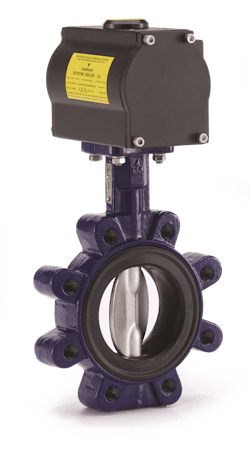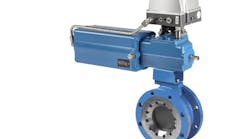The market for flow control valves is highly diverse and applicable to a wide range of industries around the world. As the market sector increasingly demands higher efficiencies, valve manufacturers continue to focus on increasing life cycles of products for their customers who demand a much lower cost of ownership throughout the life of the valve while ensuring it remains safety compliant.
Butterfly valves
Butterfly valves offer an effective shutoff method for the isolation and regulation of fluid flow. A successor to traditional gate valve technologies — which were heavy, difficult to install and did not provide the tight shutoff required to prevent emissions and production inefficiencies — butterfly valves were developed in 1950 as a smaller, lighter alternative that would effectively address leakage issues.
The first series of butterfly valves on the market were resilient seated butterfly valves, which were used to replace gate valves in low-pressure, low-temperature environments such as utility applications. These resilient seated butterfly valves are elastomer-lined and have a concentric disc design, which means the disc and shaft are in the center of the valve body and pipe. The disc rotates 90 degrees from fully closed to fully open and can be fitted with either a manual or power actuator. Rotating the actuator moves the disc to either restrict or permit flow through the pipe. This design allowed users to regulate flow through their systems.
As the industry became more familiar with butterfly valve technologies, end users realized their more compact, lighter weight design could be used to help combat emissions and safety challenges in a wider range of applications.
With the emergence of developments in elastomer-lined resilient seated butterfly valves, end users were able to use them in applications with higher temperatures and more corrosive services, such as light corrosive service, food service and hot air. One example of this development was Emerson’s Keystone Figure 990/920 with TFE seats, which was popular in replacing other valve types in food and beverage applications.
However, as end users started to push butterfly valve technologies to their limits with more severe conditions and higher standards for emissions control and safety, the high-performance butterfly valve was created as the next evolution.
This new valve design featured a double-offset disc that reduced rubbing and wear on the seat, which extended the life of the valve. It could also withstand applications up to 1000ºF (537ºC) and pressures up to 1480 psi. Hence, the high-performance butterfly valve began to appear in high cycle services.
This performance allowed the butterfly valve to be used in many applications and a wide range of industries, providing modulation and control of processes, including steam, hydrocarbons, high-temperature applications and high-pressure applications.
However, there remained a gap in the market. The desire from customers for a valve that was more efficient and safe drove demand for a metal seated valve that provided a tight shutoff, which neither the gate valve nor high-performance butterfly valve could adequately deliver.
To solve this issue, the triple-offset butterfly valve was developed. The first in achieving bidirectional zero leakage according to international standards, triple-offset valves (TOVs) provide tight shutoff through a combination of metal-to-metal torque seating and quarter-turn nonrubbing rotation. This type of valve solution is capable of handling the extremes of temperature and pressure while providing zero leakage metal sealing.New market challenges
Among the current challenges facing customers using butterfly valves is the compatibility of the materials used with the application conditions. To meet this challenge, valve manufacturers increasingly use new advancements in coatings for the valve bodies and discs, allowing them to be used in aggressive media.
Butterfly valves are not used in applications that require large pressure drops. In addition, due to the disc in the flow path, they cannot be used in applications where a through conduit valve is needed. They can provide a solution for modulating services, but not where tight control is required.
Solutions fit for industry
Butterfly valves, such as Emerson’s Keystone valve portfolio, can be used for a diverse range of industries including chemical, petrochemical, oil and gas, power, institutional, pulp and paper and general industrial applications. A basic design is customized to fit each region’s requirements. This may include drillings, materials of construction and certifications unique to each local area.
For continued research and development of butterfly valve design technologies, including new materials and industry standards, safety and emissions are the driving forces. Operators can benefit from safer increased life cycles at a lower cost.
Joanne Lunsford is the product director for Emerson’s Keystone butterfly valve range. She has worked in the valve industry for 37 years, chiefly in product management and sales. Based in Houston, Lunsford is a graduate in industrial marketing from Texas A&M University.



